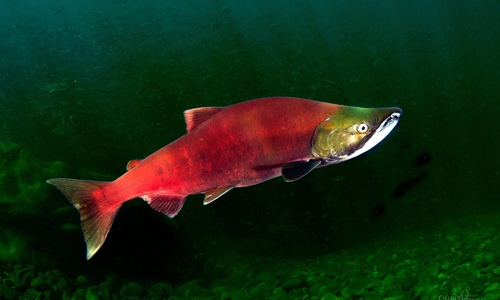
Sockeye Salmon
The Atlantic bluefin tuna (Thunnus thynnus) is a highly migratory, large pelagic fish renowned for its size, speed, and commercial value. It plays a crucial role in the marine ecosystem and is a top predator. This species faces significant conservation challenges.
3 8 years
Lifespan
45 - 84 cm
Length
Least Concern
Conservation Status
40 km/h
Swimming speed
Planktivorous, Filter Feeding
Diet
Highly Migratory, Diadromous Migration - Anadromous
Migration
Appearance Overview
The Atlantic bluefin tuna is renowned for its large, torpedo-shaped body, built for speed and endurance.
Coloration
Dark metallic blue above, silvery-white below
Fins
Two dorsal fins, the first depressible; small finlets behind second dorsal and anal fins
Body Shape
Streamlined, fusiform body
Length
Up to 13 feet (4 meters)
Weight
Up to 2,000 lbs (907 kg)
Diet
Carnivorous, feeding on a variety of fish, squid, crustaceans, and eels.
Feeding Behavior
Highly active predator that uses speed and agility to hunt. Often hunts cooperatively, herding prey.
Social Behavior
Forms schools, sometimes segregated by size. Highly migratory, capable of crossing oceans.
Commercial Relevance
Extremely high value, particularly in the sushi and sashimi markets, where it can fetch premium prices.
Conservation measures
Subject to international fishing quotas, stock management plans, and monitoring efforts by organizations like ICCAT.
Status
Varies by population; some are considered Endangered or Critically Endangered, while others are Near Threatened.
Threats
Historically overfished, particularly due to demand for sushi. Other threats include bycatch and habitat degradation.
Habitat Distribution
Depth Range
Surface waters to depths of over 3,000 feet (900 meters)
Geographic Range
Atlantic Ocean, Mediterranean Sea, and formerly the Black Sea
Preferred Environment
Primarily pelagic, inhabiting temperate and subtropical waters
Reproduction and Life Cycle
Breeding Habits
Spawns in warm waters, with major spawning grounds in the Mediterranean Sea and the Gulf of Mexico.
Development Stages
Eggs hatch into larvae, which develop rapidly. Juveniles grow quickly, feeding in productive waters.
Fecundity
Females can produce up to 30 million eggs per spawning season.
Maturity Age
Maturity varies by location, but generally between 4-8 years.
Faqs about Sockeye Salmon
How long do Atlantic bluefin tuna live?
Atlantic bluefin tuna can live up to 40 years.
How fast can Atlantic bluefin tuna swim?
They are among the fastest fish in the ocean, capable of bursts of speed up to 43 mph (70 km/h).
Are Atlantic bluefin tuna warm-blooded?
Yes, they are warm-blooded, which helps them maintain high activity levels in cold waters.
What's the largest Atlantic bluefin tuna ever caught?
The record is around 1,496 lbs (679 kg), caught off Nova Scotia in 1979.
Do Atlantic bluefin tuna migrate?
They undertake extensive migrations for feeding and spawning, sometimes crossing entire oceans.
How many eggs can a female bluefin tuna lay?
Females can release millions of eggs during a spawning season.
Where are Atlantic Bluefin tuna found?
They are found in the western and eastern Atlantic Ocean, and the Mediterranean Sea.
Copyright @ Nature Style Limited. All Rights Reserved.
 English
English